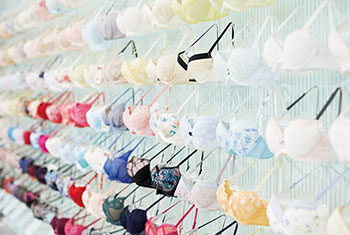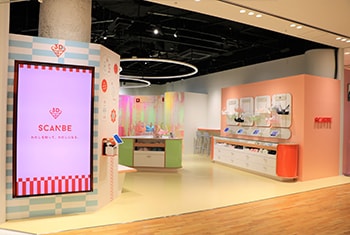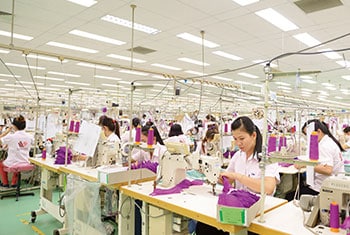
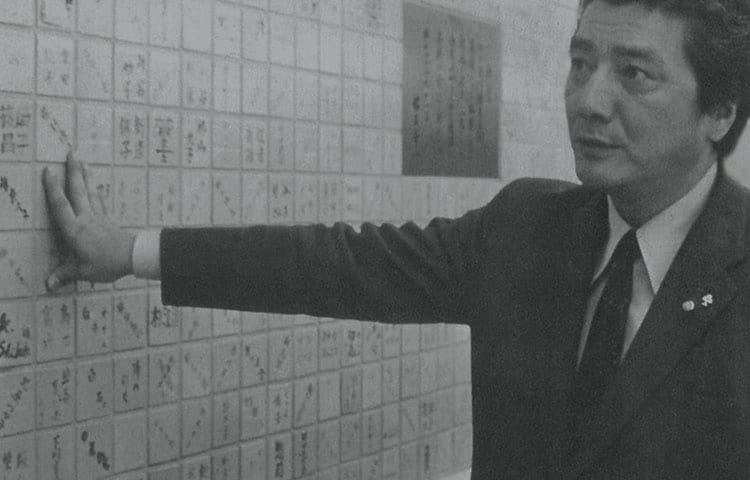
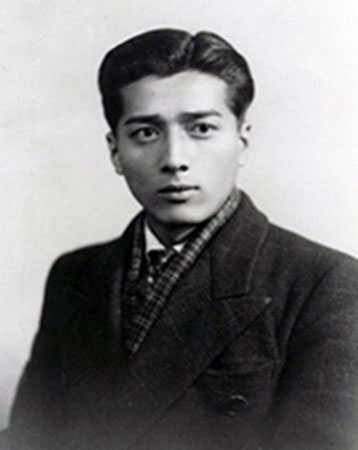
With a strong desire to devote his life to working for society, Koichi Tsukamoto founded Wacoal based on the belief that “a peaceful society is one where women can express their beauty.” His goal was to contribute to society by helping people to express their beauty. In achieving this goal, business management based on mutual trust is essential. The Group has overcome numerous hardships over its long history based on its founder’s strong commitment to creating a company trusted by all stakeholders.
Founding
1946

Koichi Tsukamoto, who had miraculously survived World War II’s harsh battles, returned to his home in Kyoto on June 15, 1946, and started a business dealing in women’s personal ornaments that very day. This is the date of Wacoal’s founding.
The Company’s initial trade name was Wako Shoji. In 1949, Tsukamoto’s strong desire to “help Japanese women express their beauty” and an encounter with “bra pads” brought about a decisive turn in the business. Thus Wako Corp., incorporating a global perspective, was established as a manufacturer of women’s western underwear.
The Company’s initial trade name was Wako Shoji. In 1949, Tsukamoto’s strong desire to “help Japanese women express their beauty” and an encounter with “bra pads” brought about a decisive turn in the business. Thus Wako Corp., incorporating a global perspective, was established as a manufacturer of women’s western underwear.
Opening sales channels in department stores
1950
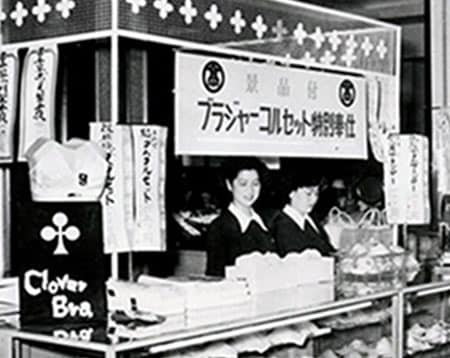
In 1950, Wacoal opened its first women's underwear sales counter in a department store at the Kyoto branch of Takashimaya.
Seizing upon the opportunity presented by women in Japan undertaking a big shift from Japanese to western clothing, Wacoal started designing women's western underwear and manufacturing it at its own factory. During this period of high economic growth and an increasing interest in fashion and life quality demonstrated by women, the company produced various products to meet their needs.
Seizing upon the opportunity presented by women in Japan undertaking a big shift from Japanese to western clothing, Wacoal started designing women's western underwear and manufacturing it at its own factory. During this period of high economic growth and an increasing interest in fashion and life quality demonstrated by women, the company produced various products to meet their needs.
Establishing a corporate culture based on mutual trust
1962
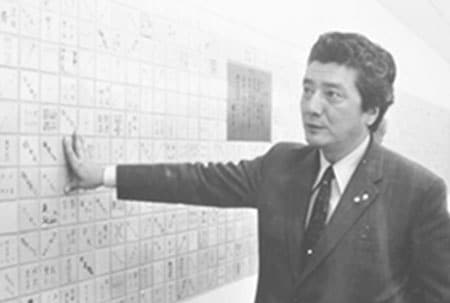
In 1962, labor-management relations were a major issue. Wacoal founder, Koichi Tsukamoto, was deeply moved upon hearing a lecture given by the president of Idemitsu Kosan, Sazo Idemitsu.
Tsukamoto, thinking, "If we are going to talk about respect for human beings, firstly, the president must have faith in the union." So, he acted decisively to establish a "corporate culture of mutual trust" by entrusting employees to make their own decisions regarding matters such as arriving late and leaving early.
This action revitalized the mood within the company and served as a foundation for generating further growth.
Tsukamoto, thinking, "If we are going to talk about respect for human beings, firstly, the president must have faith in the union." So, he acted decisively to establish a "corporate culture of mutual trust" by entrusting employees to make their own decisions regarding matters such as arriving late and leaving early.
This action revitalized the mood within the company and served as a foundation for generating further growth.
The start of human science research
1964
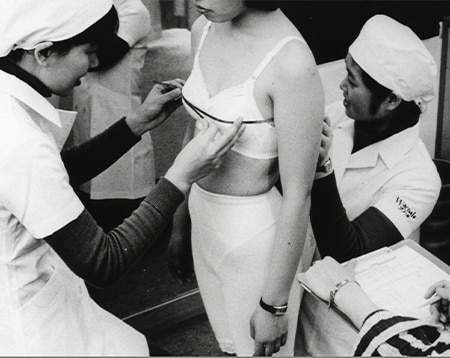
To create products that perfectly fit the body shape of Japanese women, the Company established a Product Research Department in a building that was newly opened in Asakusabashi, Tokyo, in 1964. There, the Company started full-scale research and measuring the body shapes of Japanese women based on ergonomics. In addition to establishing a brassiere size system, anthropometric data were collected, and based on that, the ideal female body shape was expressed in numerical form. The Product Research Department eventually developed into the Human Science Research Center, and in addition to collecting body shape data, the Center has expanded its areas of research to include comfort, health, and movement.
Developing overseas markets
1970
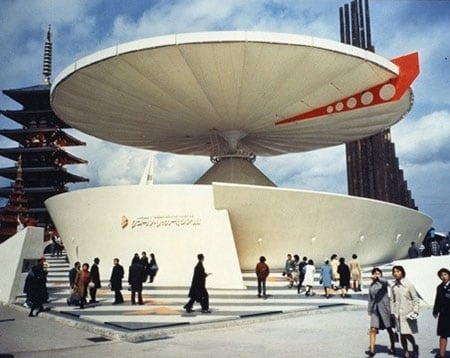
‐Riccar at The Japan World Exposition
At the Japan World Exposition held in Senri, Osaka, in 1970, Wacoal exhibited at the Wacoal Riccar Sewing Machine Hall, a venue it jointly collaborated on with the Riccar Sewing Machine Company. "Expo Weddings," which recruited couples internationally to hold wedding ceremonies at the Expo site, attracted a great deal of attention.
Additionally, the company ran a series of advertisements in an American specialty journal, a first for a company from Japan in the industry, and began promoting the Wacoal corporate stance to an overseas audience. In the same year, Wacoal established joint venture companies in South Korea, Thailand, and Taiwan. Manufactured products were imported for the mass retailer market in Japan, and at the same time, local sales began in Taiwan and Thailand. This marked Wacoal's first steps toward global expansion, starting from the Asian region.
Additionally, the company ran a series of advertisements in an American specialty journal, a first for a company from Japan in the industry, and began promoting the Wacoal corporate stance to an overseas audience. In the same year, Wacoal established joint venture companies in South Korea, Thailand, and Taiwan. Manufactured products were imported for the mass retailer market in Japan, and at the same time, local sales began in Taiwan and Thailand. This marked Wacoal's first steps toward global expansion, starting from the Asian region.
Developing the mass retailer channel
1975
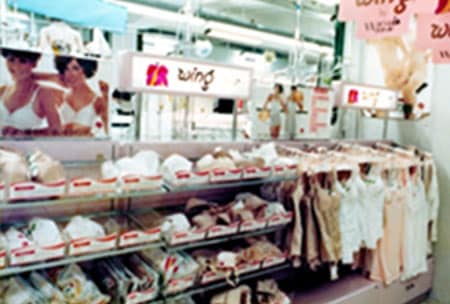
In the 1970s, mass retailers overtook department stores in clothing sales and grew into huge distribution channels. It was a turning point for the Company when mass retailers began to shift from selling large quantities of generic products to offering bargain sales on national brands. As a result of continued negotiations with major mass retailers, the national brand Wing was displayed in the lingerie sections of mass retailers on the premise that dedicated sales corners would be established and listed prices respected.
Expanding overseas markets
1981
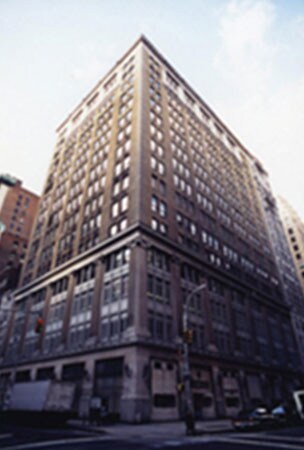
In addition to establishing Wacoal America Inc. (currently Wacoal International Corp) in the United States in 1981 and Wacoal Hong Kong Co., Ltd. in Hong Kong in 1983, Wacoal also became the first Japanese apparel company to set up a joint venture in China. By developing a unique overseas business model rooted in local areas, the foundation for a global Wacoal was being laid.
An earnest desire for profitability in the US
1995
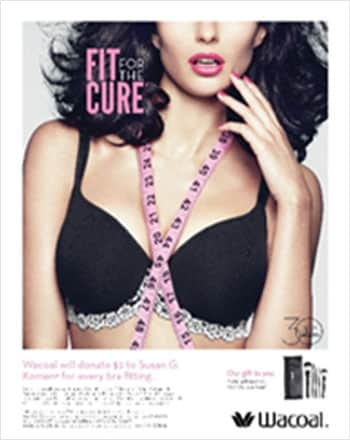
After entering the U.S. market, the Company’s performance stagnated for many years because of bloated inventory and SG&A expenses. Even so, Wacoal improved quality at its plants while maintaining listed prices and a commitment to sales through consultations with beauty advisors, and in 1995, it achieved profitability for the first time.
Starting the directly managed store business
2001
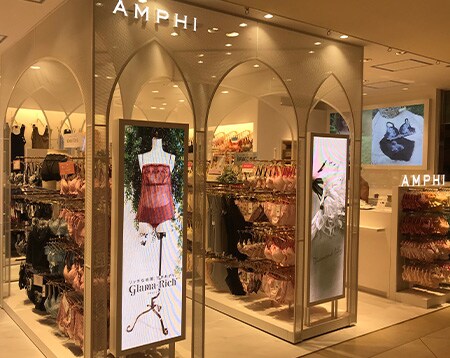
With the relative status of department stores and mass retailers declining and that of fashion-oriented buildings, station buildings, and shopping malls on the rise, in 2001, Wacoal opened its first SPA-style directly managed store, Subito, in Harajuku, Tokyo. Since then, the Company has opened a series of stores in various styles that are tailored to specific customer bases and store locations as it continues to take on the challenge of increasing customer footfall.
Starting full-scale development
in the European market
2012
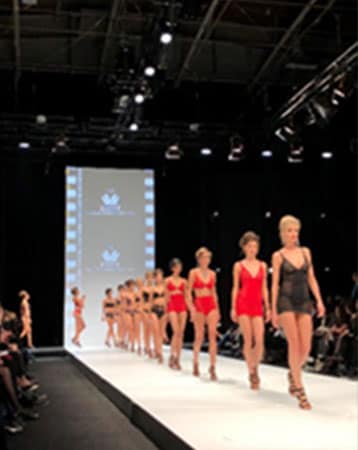
In 2012, aiming to expand the European business, Eveden Group Limited (currently Wacoal Europe Ltd.), a company with multiple brands suited to a wide range of body shapes and sizes and headquartered in the UK, was made a wholly-owned subsidiary. From that point on, Wacoal’s presence in the UK and the EU grew signicantly. The Company is completing post-acquisition reorganization and building a stronger revenue through such activities as reviewing the brand portfolio. Having completed a post-acquisition reorganization, the Company is building a stronger revenue base by reviewing the brand portfolio.
Aiming for a Globalized Wacoal Group
2019
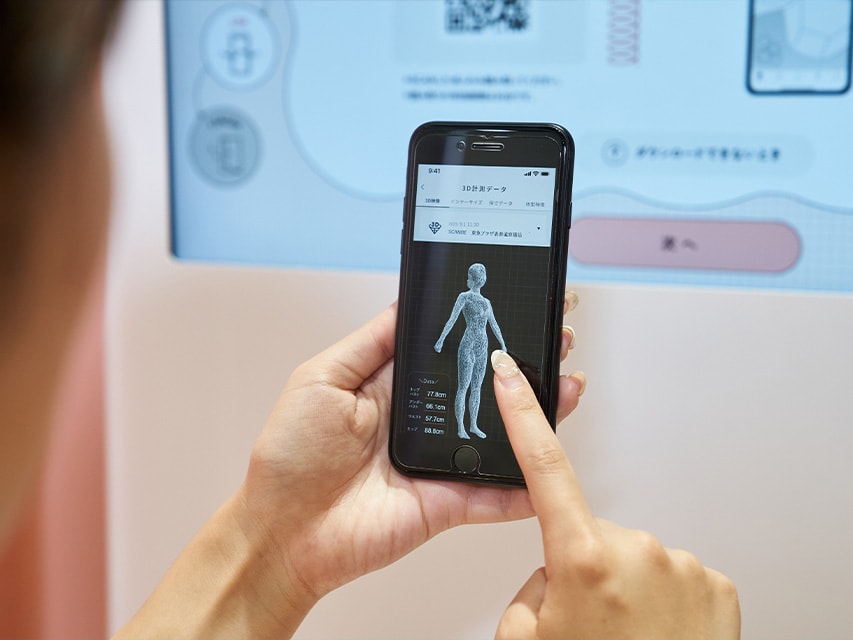
Aiming for a Globalized Wacoal Group
In 2019, Wacoal opened a next-generation innerwear store called Wacoal 3D smart & try. The store introduced new customer experiences that utilize Wacoal's proprietary 3D body scanner and AI-enabled customer services. These new customer services are not limited to next-generation stores. Going forward, they will be expanded to stores in various channels, changing customer experiences for the future.
Utilizing data such as measurement data accumulated since embarking upon human science research in 1964, along with data obtained via new technology such as the 3D body scanner, Wacoal is accelerating its shift toward a business model based on the utilization of customer data. The company will continue to aim for further growth and serve as a pioneer in underwear culture by providing services and value in line with changes in customer needs and behavior.
Wacoal, which celebrated its 70th anniversary in November 2019, will continue to fully leverage the Group's network. And by constantly enhancing a structure that can deliver pioneering products and services to the global market in response to customer changes, Wacoal will continue to take on the challenge of becoming a global leader, a goal that has served as the company's motto since its founding.
In 2019, Wacoal opened a next-generation innerwear store called Wacoal 3D smart & try. The store introduced new customer experiences that utilize Wacoal's proprietary 3D body scanner and AI-enabled customer services. These new customer services are not limited to next-generation stores. Going forward, they will be expanded to stores in various channels, changing customer experiences for the future.
Utilizing data such as measurement data accumulated since embarking upon human science research in 1964, along with data obtained via new technology such as the 3D body scanner, Wacoal is accelerating its shift toward a business model based on the utilization of customer data. The company will continue to aim for further growth and serve as a pioneer in underwear culture by providing services and value in line with changes in customer needs and behavior.
Wacoal, which celebrated its 70th anniversary in November 2019, will continue to fully leverage the Group's network. And by constantly enhancing a structure that can deliver pioneering products and services to the global market in response to customer changes, Wacoal will continue to take on the challenge of becoming a global leader, a goal that has served as the company's motto since its founding.

